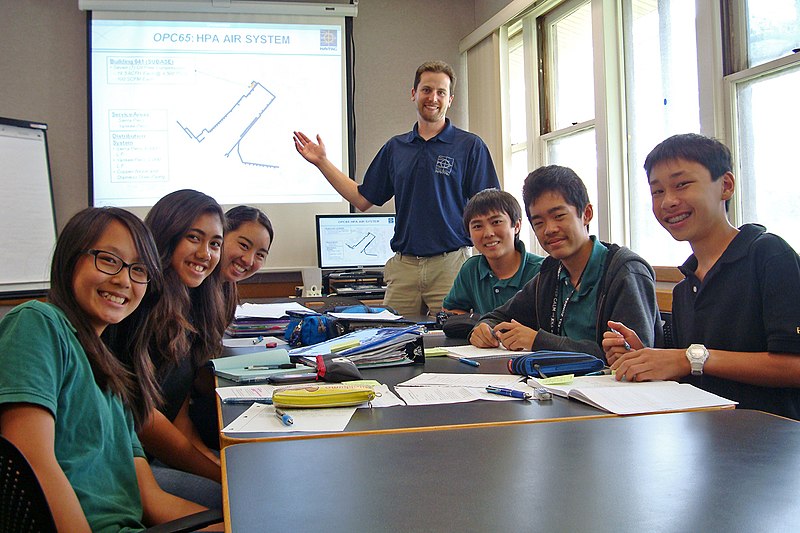
NAVFAC, Hawaii Baptist Academy Science Class Career Day at NAVFAC Hawaii (8703943954), CC BY 2.0
Teaching is a rewarding yet taxing career choice. The passion you felt at first may wane with the passage of time, and that’s okay. Some teachers experience burnout and require a break from the classroom. Others wish to pursue other interests and passions. Either way, the transition from teaching to a different career path can be a challenge in itself.
If you are transitioning from the classroom to another career, the following tips can make the change easier. They also reflect different reasons for and modes of making such a change. All of the tips may not apply to your situation, but no doubt one or more will ease your transition.
Overcome the Culture Shock
Classrooms and institutions have cultures all their own, whether you’re used to working with small children, teenagers, or university students. When you transition to a different work environment, you may experience a degree of culture shock.
Doing something called job shadowing is one way to avoid this. Before accepting a new position, you can “shadow” someone who works in the field to learn what their day is like, including their duties, work environment, stress levels, and work/life balance.
You’re no doubt familiar with job shadowing—it is precisely what you did as a student teacher. The good news is that you won’t need to spend months shadowing someone; a day is usually sufficient. You may even choose to shadow professionals in several different fields in order to make an informed decision.
Consider taking time to shadow others over summer vacation or other breaks from teaching before resigning from your current position.
Researching the company culture is another way of ensuring a good fit before taking a new job. Some companies are strict and formal while others are more lenient and creative.
Go With What You Know
Many former teachers have found success in transitioning to an industry related to the subject they teach. A chemistry teacher may decide to go into research or product development, for instance.
Or you may choose to return to the career that led you to teach in the first place. For example, you may have pursued a law career for a time before shifting to teaching law at a university.
Making such a transition is that much easier because you already have the educational background and perhaps even work experience in the field. You likely also have professional contacts who can help you locate an opening or provide a referral.
Strive for a Work/Life Balance
CNBC recently reported on a teacher who quit her job to work at Costco. Her income increased by 50 percent and she was quoted as saying “I’ve never been happier.”
Her reason for doing so wasn’t simply to make more money. She wanted a better work/life balance—more time with her family and a clear divide between her professional and personal lives. This was possible because her weekly workload was reduced from 60 to 40 hours.
This is one example of the so-called “lazy girl job” trend, the purpose of which is to fight burnout. The idea is that an exhausting, traditionally lauded career is not superior to one that pays well but allows for leisure time.
If you decide to take a job some consider less exciting or meaningful than teaching, don’t fret. Jobs like these can make you feel more fulfilled by allowing you to focus on things that are important to you while maintaining good mental health.
Redirect Your Passion for Teaching
If you became a teacher for the sheer joy of imparting knowledge to others, you can find that same fulfillment in other fields. These vary widely, and many utilize niche skill sets or interests.
You can experience the joy of teaching others outside the classroom in such jobs as:
- Travel agent—teach others about destinations, cultures, and how to navigate global transit systems.
- Remote online teaching—From piano lessons to English as a second language with global students, this job offers ultimate flexibility. Some companies favor those with teaching degrees.
- Coaching—sports coaching children or adults, or working one-on-one with clients as a life coach.
- Childcare—give small children a strong foundation by educating them early, often in smaller groups than in a traditional classroom setting.
- Niche classes—connect with local organizations or start your own business to share your knowledge with others. Whether it’s crafting classes at the community center, foraging for edibles in local wild spaces, or something in between, others will be eager to benefit from your wisdom.
Key Takeaways
Don’t let teacher burnout get you down. You can ease your transition by learning all you can about your new career, entering a related field, finding an ideal work/life balance, or redirecting your passion for teaching into other venues.
Your experience as a teacher is valuable. It is a part of you—but so is the next exciting phase of your career journey.